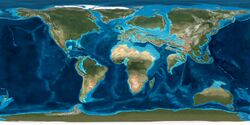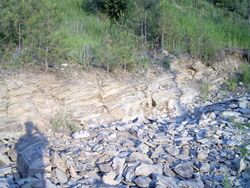Earth:Ypresian
| Ypresian | |
|---|---|
| 56.0 – 47.8 Ma | |
 Earth ~50 mya | |
 Klondike Mountain Formation, Republic, Washington | |
| Chronology | |
| Formerly part of | Tertiary Period/System |
| Etymology | |
| Name formality | Formal |
| Usage information | |
| Celestial body | Earth |
| Regional usage | Global (ICS) |
| Time scale(s) used | ICS Time Scale |
| Definition | |
| Chronological unit | Age |
| Stratigraphic unit | Stage |
| First proposed by | Dumont |
| Time span formality | Formal |
| Lower boundary definition | Strong negative anomaly in δ13C values at the PETM[3] |
| Lower boundary GSSP | Dababiya section, Luxor, Egypt[3] [ ⚑ ] 25°30′00″N 32°31′52″E / 25.5000°N 32.5311°E |
| GSSP ratified | 2003[3] |
| Upper boundary definition | FAD of the calcareous nannofossil Blackites inflatus |
| Upper boundary GSSP | Gorrondatxe section, Western Pyrenees, Basque Country, Spain [ ⚑ ] 43°22′47″N 3°00′51″W / 43.3796°N 3.0143°W |
| GSSP ratified | April 2011[4] |
In the geologic timescale the Ypresian is the oldest age or lowest stratigraphic stage of the Eocene. It spans the time between 56 and 47.8 Ma, is preceded by the Thanetian Age (part of the Paleocene) and is followed by the Eocene Lutetian Age. The Ypresian is consistent with the lower Eocene.
Events
The Ypresian Age begins during the throes of the Paleocene–Eocene Thermal Maximum (PETM). The Fur Formation in Denmark , the Messel shales in Germany , the Oise amber of France and Cambay amber of India are of this age. The Eocene Okanagan Highlands are an uplands subtropical to temperate series of lakes from the Ypresian.[5][6][7]
The Ypresian is additionally marked by another warming event called the Early Eocene Climatic Optimum (EECO). The EECO is the longest sustained warming event in the Cenozoic record, lasting about 2–3 million years between 53 and 50 Ma. The interval is characterized by low oxygen 18 isotopes,[8][9][10] high levels of atmospheric pCO2,[11][12] and low meridional thermal gradients.[13] Biodiversity has been reported to have been significantly impacted by the conditions prevalent during the EECO. For instance, there were biotic turnovers among marine producers such as calcerous nannofossil among others etc.[14][15]
Stratigraphic definition
The Ypresian Stage was introduced in scientific literature by Belgian geologist André Hubert Dumont in 1850. The Ypresian is named after the Flemish city of Ypres in Belgium (spelled Ieper in Dutch). The definitions of the original stage were totally different from the modern ones.[16] The Ypresian shares its name with the Belgian Ieper Group (French: Groupe d'Ypres), which has an Ypresian age.
The base of the Ypresian Stage is defined at a strong negative anomaly in δ13C values at the PETM. The official reference profile (GSSP) for the base of the Ypresian is the Dababiya profile near the Egyptian city of Luxor.[17] Its original type section was located in the vicinity of Ieper.
The top of the Ypresian (the base of the Lutetian) is identified by the first appearance of the foraminifera genus Hantkenina in the fossil record.
The Ypresian Stage overlaps the upper Neustrian and most of the Grauvian European Land Mammal Mega Zones (it spans the Mammal Paleogene zones 7 through 10.[18]), the Wasatchian and lower and middle Bridgerian North American Land Mammal Ages, the Casamayoran South American Land Mammal Age and the Bumbanian and most of the Arshantan Asian Land Mammal Ages. It is also coeval with the upper Wangerripian and lowest Johannian regional stages of Australia and the Bulitian, Penutian, and Ulatisian regional stages of California .
References
- ↑ Zachos, J. C.; Kump, L. R. (2005). "Carbon cycle feedbacks and the initiation of Antarctic glaciation in the earliest Oligocene". Global and Planetary Change 47 (1): 51–66. doi:10.1016/j.gloplacha.2005.01.001. Bibcode: 2005GPC....47...51Z.
- ↑ "International Chronostratigraphic Chart". International Commission on Stratigraphy. https://stratigraphy.org/icschart/ChronostratChart2020-01.pdf.
- ↑ 3.0 3.1 3.2 Aubry, Marie-Pierre; Ouda, Khaled; Dupuis, Christian; William A. Berggren; John A. Van Couvering; Working Group on the Paleocene/Eocene Boundary (2007). "The Global Standard Stratotype-section and Point (GSSP) for the base of the Eocene Series in the Dababiya section (Egypt)". Episodes 30 (4): 271–286. doi:10.18814/epiiugs/2007/v30i4/003. http://www.stratigraphy.org/GSSP/file11.pdf.
- ↑ Molina, Eustoquio; Alegret, Laia; Apellaniz, Estibaliz; Bernaola, Gilen; Caballero, Fernando; Jaume Dinarès-Turell; Hardenbol, Jan; Claus Heilmann-Clausen et al. (2011). "The Global Stratotype Section and Point (GSSP) for the base of the Lutetian Stage at the Gorrondatxe section, Spain". Episodes 34 (2): 86–108. doi:10.18814/epiiugs/2011/v34i2/006. http://wzar.unizar.es/perso/emolina/pdf/Molina2011Episodes.pdf.
- ↑ Greenwood, D.R.; Archibald, S.B.; Mathewes, R.W; Moss, P.T. (2005). "Fossil biotas from the Okanagan Highlands, southern British Columbia and northeastern Washington State: climates and ecosystems across an Eocene landscape". Canadian Journal of Earth Sciences 42 (2): 167–185. doi:10.1139/e04-100. Bibcode: 2005CaJES..42..167G.
- ↑ Archibald, S.; Greenwood, D.; Smith, R.; Mathewes, R.; Basinger, J. (2011). "Great Canadian Lagerstätten 1. Early Eocene Lagerstätten of the Okanagan Highlands (British Columbia and Washington State)". Geoscience Canada 38 (4): 155–164.
- ↑ Lowe, A. J.; Greenwood, D. R.; West, C. K.; Galloway, J. M.; Sudermann, M.; Reichgelt, T. (2018). "Plant community ecology and climate on an upland volcanic landscape during the Early Eocene Climatic Optimum: McAbee Fossil Beds, British Columbia, Canada". Palaeogeography, Palaeoclimatology, Palaeoecology 511: 433–448. doi:10.1016/j.palaeo.2018.09.010. Bibcode: 2018PPP...511..433L.
- ↑ Bijl, Peter K.; Schouten, Stefan; Sluijs, Appy; Reichart, Gert-Jan; Zachos, James C.; Brinkhuis, Henk (October 2009). "Early Palaeogene temperature evolution of the southwest Pacific Ocean" (in en). Nature 461 (7265): 776–779. doi:10.1038/nature08399. ISSN 1476-4687. PMID 19812670. Bibcode: 2009Natur.461..776B. https://www.nature.com/articles/nature08399.
- ↑ Hollis, Christopher J.; Handley, Luke; Crouch, Erica M.; Morgans, Hugh E.G.; Baker, Joel A.; Creech, John; Collins, Katie S.; Gibbs, Samantha J. et al. (2009-02-01). "Tropical sea temperatures in the high-latitude South Pacific during the Eocene". Geology 37 (2): 99–102. doi:10.1130/g25200a.1. ISSN 1943-2682. Bibcode: 2009Geo....37...99H. https://doi.org/10.1130/G25200A.1.
- ↑ Zachos, James; Pagani, Mark; Sloan, Lisa; Thomas, Ellen; Billups, Katharina (2001-04-27). "Trends, Rhythms, and Aberrations in Global Climate 65 Ma to Present" (in en). Science 292 (5517): 686–693. doi:10.1126/science.1059412. ISSN 0036-8075. PMID 11326091. Bibcode: 2001Sci...292..686Z. https://www.science.org/doi/10.1126/science.1059412.
- ↑ Beerling, David J.; Royer, Dana L. (July 2011). "Convergent Cenozoic CO2 history" (in en). Nature Geoscience 4 (7): 418–420. doi:10.1038/ngeo1186. ISSN 1752-0908. Bibcode: 2011NatGe...4..418B. https://www.nature.com/articles/ngeo1186.
- ↑ Zachos, James C.; Dickens, Gerald R.; Zeebe, Richard E. (January 2008). "An early Cenozoic perspective on greenhouse warming and carbon-cycle dynamics" (in en). Nature 451 (7176): 279–283. doi:10.1038/nature06588. ISSN 1476-4687. PMID 18202643. Bibcode: 2008Natur.451..279Z.
- ↑ Cramwinckel, Margot J.; Huber, Matthew; Kocken, Ilja J.; Agnini, Claudia; Bijl, Peter K.; Bohaty, Steven M.; Frieling, Joost; Goldner, Aaron et al. (July 2018). "Synchronous tropical and polar temperature evolution in the Eocene" (in en). Nature 559 (7714): 382–386. doi:10.1038/s41586-018-0272-2. ISSN 1476-4687. PMID 29967546. Bibcode: 2018Natur.559..382C. https://www.nature.com/articles/s41586-018-0272-2.
- ↑ Cappelli, C.; Bown, P. R.; Westerhold, T.; Bohaty, S. M.; Riu, M.; Lobba, V.; Yamamoto, Y.; Agnini, C. (December 2019). "The Early to Middle Eocene Transition: An Integrated Calcareous Nannofossil and Stable Isotope Record From the Northwest Atlantic Ocean (Integrated Ocean Drilling Program Site U1410)" (in en). Paleoceanography and Paleoclimatology 34 (12): 1913–1930. doi:10.1029/2019PA003686. ISSN 2572-4517. Bibcode: 2019PaPa...34.1913C.
- ↑ Schneider, Leah J.; Bralower, Timothy J.; Kump, Lee R. (October 2011). "Response of nannoplankton to early Eocene ocean destratification" (in en). Palaeogeography, Palaeoclimatology, Palaeoecology 310 (3–4): 152–162. doi:10.1016/j.palaeo.2011.06.018. Bibcode: 2011PPP...310..152S. https://linkinghub.elsevier.com/retrieve/pii/S0031018211003373.
- ↑ Steurbaut (2006)
- ↑ The GSSP was established by Dupuis et al. (2003)
- ↑ Alroy, John. "Mammal Paleogene zones". p. The Paleobiology Database. http://paleodb.org/cgi-bin/bridge.pl?action=processViewScale&scale_no=125.
Literature
- Dumont, A. H.; 1850: Rapport sur la carte géologique du Royaume, Bulletins de l’Académie Royale des Sciences, des Lettres et des Beaux-Arts de Belgique 16 (2), pp. 351–373. (in French)
- Dupuis, C.; Aubry, M.; Steurbaut, É; Berggren, W. A.; Ouda, K.; Magioncalda, R.; Cramer, B. S.; Kent, D. V.; Speijer, R. P. & Heilmann-Clausen, C.; 2003: The Dababiya Quarry Section: Lithostratigraphy, clay mineralogy, geochemistry and paleontology, Micropaleontology 49 (1), pp. 41–59, ISSN 0026-2803.
- Gradstein, F. M.; Ogg, J. G. & Smith, A. G.; 2004: A Geologic Time Scale 2004, Cambridge University Press .
- Steurbaut, É.; 2006: Ypresian , Geologica Belgica 9 (1–2), pp. 73–93.
External links
- GeoWhen Database – Ypresian
- Paleogene timescale, at the website of the subcommission for stratigraphic information of the ICS
- Stratigraphic chart of the Paleogene, at the website of Norges Network of offshore records of geology and stratigraphy
 |
